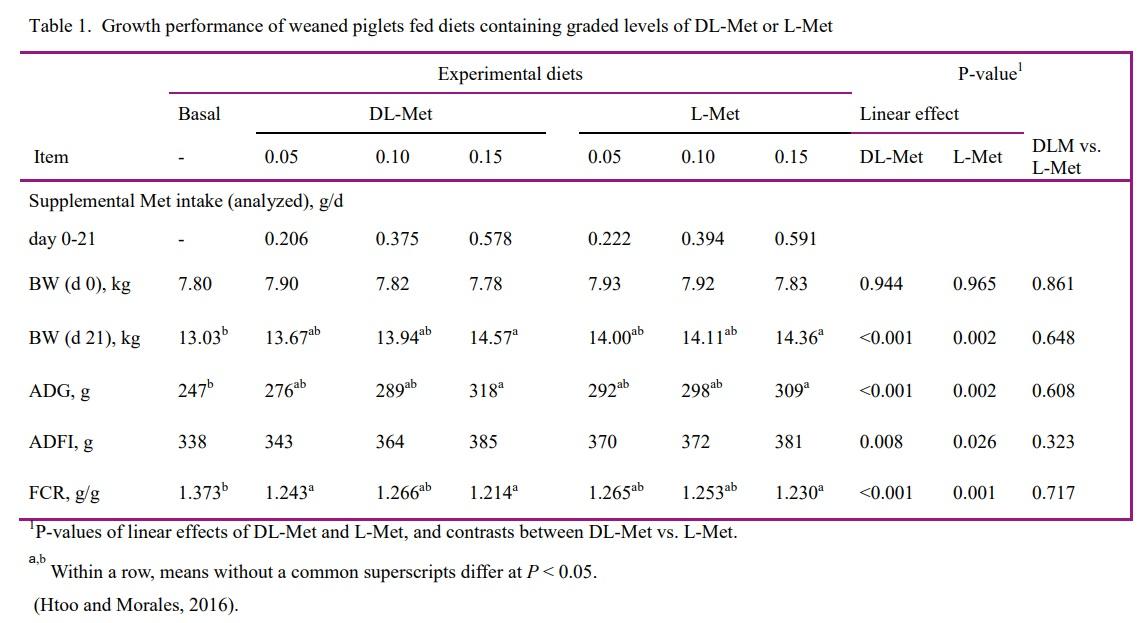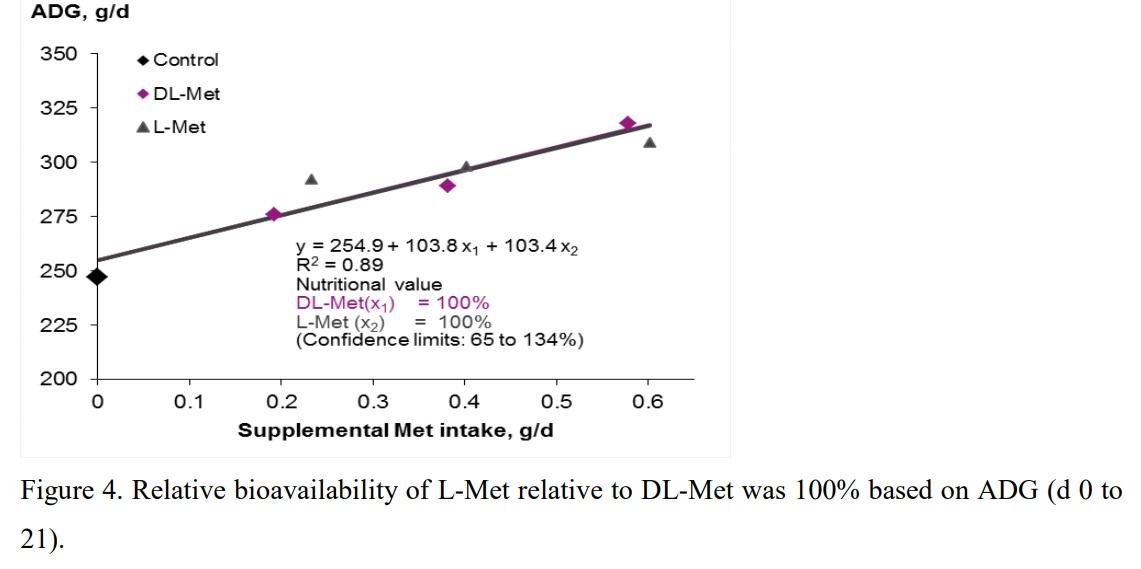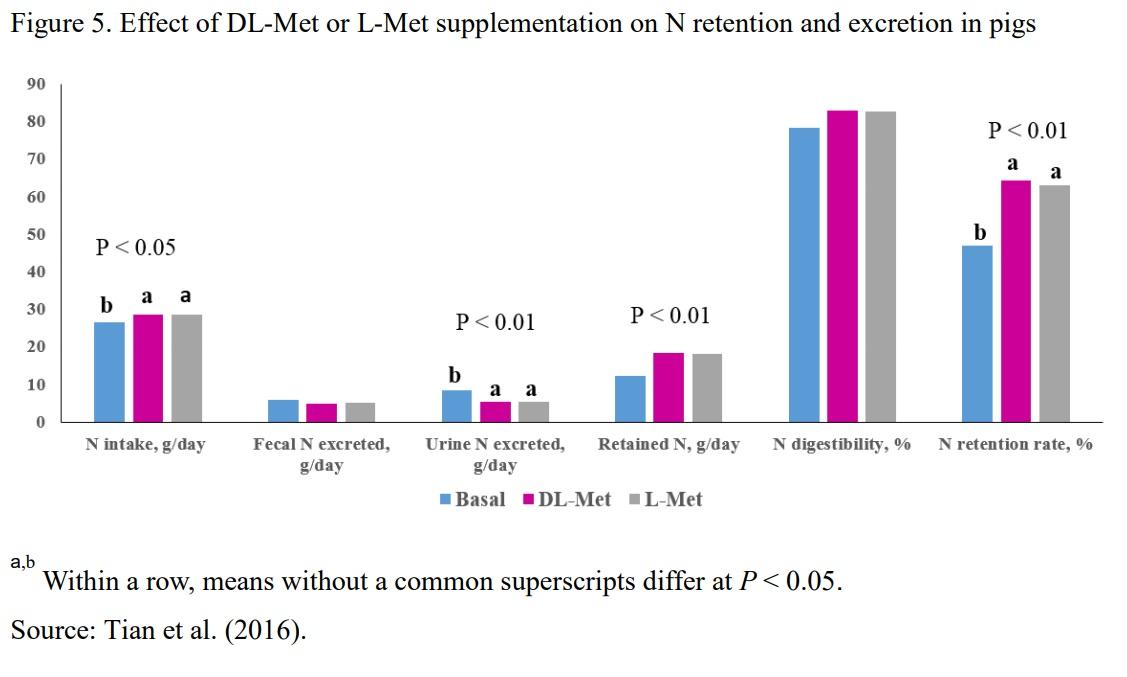
Selecting the Correct Methionine Source – A Key Index for Successful Pig Production






Baker, D. H. 1994. Utilization of precursors for L-amino acids. In: J. P. F. D’Mello, editor, Amino acids in farm animal nutrition. CAB Int., Wallingford, UK. p. 37–64.
Baker, D.H. 2006. Comparative species utilization and toxicity of sulfur amino acids. The J. of Nutr. 136:1670S-1675S.
Bunchasak, C. 2009. Role of dietary methionine in poultry production. The Journal of Poultry Science, 46: 169-179.
Chen, Y., X. Piao, P. Zhao, and Z. Zeng. 2013. Efficiency estimation and effects of standardized ileal digestible methionine level on growth performance, nutrient digestibility and plasma parameters of weaner piglets. Chinese J. Anim. Nutr. 25:2430–2439.
Dilger, R.N. and D.H. Baker. 2007. DL-Methionine is as efficacious as L-methionine, but modest L-cystine excesses are anorexigenic in sulfur amino acid-deficient purified and practical-type diets fed to chicks. Poultry Science 86: 2367-2374.
European Feed Safety Authority (EFSA) Journal. 2018. Safety and efficacy of hydroxy analogue of methionine and its calcium salt (ADRY+) for all animal species. 16 (3):5198.
Facts & Figures No. 1493: Supplementing MetAMINO® and MHA-Ca at a ratio of 65:100 on a product basis to a Met-deficient diet maintained similar performance in growing pigs.
Evonik Trial No. 03.63.11002 (www.aminoacidsandmore.com).
Fang, Z., H. Luo, H. Wei, F. Huang, S. Jiang, and J. Peng. 2010. Methionine metabolism in piglets fed DL-methionine or its hydroxy analogue was affected by distribution of enzymes oxidizing these sources to keto-methionine. J. Agric. Food Chem. 58:2008–2014.
Feng, Z., S. Qiao, Y. Ma, X. Wang, X. Li, and P. A. Thacker. 2006. Efficacy of methionine hydroxy analog and DL-methionine as methionine sources in growing pigs. J. Anim. Vet Adv. 5, 2:135-142.
Htoo, J. K., and J. Morales. 2016. Bioavailability of L-methionine relative to DL-Methionine as a methionine source for weaned pigs. J. Anim. Sci. 94:249-252.
Kim, B. G, M. D. Lindemann, M. Rademacher, J. J. Brennan, and G. L. Cromwell. 2006. Efficacy of DL- methionine hydroxy analog free acid and DL-methionine as methionine sources for pigs. J. Anim. Sci. 84:104–111.
Kong, C., C. S. Park, J. Y. Ahn, B. G. Kim. 2016. Relative bioavailability of dl-methionine compared with l-methionine fed to nursery pigs. Anim. Feed Sci. Tech. 215:181–185.
Li, P., Y. L.Yin, D. Li, S. W. Kim, and G.Wu. 2007. Amino acids and immune function. Br. J. Nutr. 98: 237–252.
Opapeju, F. O., J. K. Htoo, C. Dapoza, and C. M. Nyachoti. 2012. Bioavailability of methionine hydroxy analog-calcium salt relative to DL-methionine to support nitrogen retention and growth in starter pigs. Animal. 6 (11):1750-1756.
Shoveller, A. K., S. Moehn, M. Rademacher, J. K. Htoo, and R. O. Ball. 2010. Methionine hydroxy analogue was found to be significantly less bioavailable compared to DLmethionine for protein deposition in growing pigs. Animal. 4 (1):61-66.
Schmidt, J. 2000. Nitrogen retention in pigs fed different methionine sources. Report University of West Hungary, Mosonmagyarovar.
Shen, Y. B., A. C. Weaver, and S. W. Kim. 2014. Effect of feed grade L-methionine on growth performance and gut health in nursery pigs compared with conventional DL-methionine. J. Anim. Sci. 2014. 92:5530-5539.
Tian, Q. Y., Z. K. Zeng, Y. X. Zhang, S. F. Long, and X. S. Piao. 2016. Effect of L- or DLmethionine supplementation on nitrogen retention, serum amino acid concentrations and blood metabolites profile in starter pigs. Asian Australas. J. Anim. Sci. 29 (5):689-694.
van Milgen, J., J. Noblet, P. Looten, P. Fuertes, and C. Delporte. 2013. Comparative efficacy of L-methionine and DL-methionine in piglets. Journ. Rech. Porcine. 45:165–166.
Zimmermann, B., R. Mosenthin, M. Rademacher, P. B. Lynch, and E. Esteve-Garcia. Comparative Studies on the Relative Efficacy of DL-methionine and Liquid
Methionine Hydroxy Analogue in Growing Pigs. Asian-Aust. J. Anim. Sci. 2005 18, 7:1003-1010.
The data should be converted to TSAA:Lys ratio for each treatment giving 100% equivalency of methionine as added between the DL and methionine hydroxy analogue sources. This would allow the reader to assess the data in context of how the reader is formulating diets and whether the data was generated below requirement, at requirement, or above requirement as the reader defines the requirement of their pigs.
Dr John, reports consistent with information available in the literature. I think it is relevant to make it clear that the use of the D-isomer of amino acids depends on the presence of the specific D-amino acid oxidase. Therefore, the efficiency of the use of methionine D isomers by pigs is directly related to the presence of the enzyme D methionine oxidase. These considerations were made since in the text and in Figure 3, this specificity does not appear.





.jpg&w=3840&q=75)